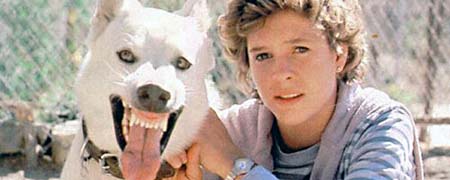WHITE DOG
(director/writer:Sam Fuller; screenwriters: Curtis Hanson/based on the Novel by Romaine Gary; cinematographer: Bruce Surtees; editor: Bernard Gribble; music: Ennio Morricone; cast: Kristy MacNichol (Julie Sawyer), Paul Winfield (Keys), Burl Ives (Carruthers), Jameson Parker (Roland Gray), Lynne Moody (Molly), Parley Baer (Wilber Hull), Karl Lewis Miller (Attacker); Runtime: 90; MPAA Rating: PG; producer: Jon Davison; Paramount; 1982)
“Compelling oddball thriller about a racist dog who only attacks blacks is directed by the always interesting Sam Fuller.”
Reviewed by Dennis Schwartz
This compelling oddball thriller about a racist dog who only attacks blacks is directed by the always interesting Sam Fuller (“Steel Helmet”/”Fixed Bayonets!”/”The Crimson Kimono”). The film never received a theatrical release, as it was deep-sixed by the foolishly nervous studio heads at Paramount preposterously thinking this was a racist work–something it’s obviously not, as its message couldn’t be clearer for racial tolerance. It’s loosely based on a novel by Romaine Gary; it’s co-scripted by Fuller and Curtis Hanson.
Aspiring actress Julie Sawyer (Kristy MacNichol) accidentally runs down a stray white German shepherd while driving at night near the luxurious home she rents. The vet saves it, and after taking it home to nurse it back to health and receiving no responses from an ad she placed in the newspaper, she decides to keep it when she learns that the pound will put it down if no one claims it. The actress lives alone in the Hollywood Hills and her boyfriend (Jameson Parker) says the dog will be a good bodyguard in such a desolate spot. This proves true when he prevents a rapist from attacking her, jumping through a closed window to mangle and capture the criminal. Later when the dog, who ran away chasing a rabbit, returns all bloody, Julie ignores what she sees. We know the dog has just returned from killing a black garbageman making his rounds. But Julie refuses to believe the worst about the dog as she has become attached to it after it saved her life. So attached that she brings the dog to work, but for no apparent reason it attacks her black actress friend Molly (Lynne Moody) and leaves her hospitalized. Not wanting to put the dog down, Julie brings it to professional Hollywood animal trainer Carruthers (Burl Ives) who recommends maverick black animal trainer Keys (Paul Winfield) to retrain it. Keys tells Julie it’s an attack White Dog that has been trained by a white racist to attack only blacks. He further states the dog can only see the colors black and white, and has been trained to only go after blacks from when he was a pup. Obsessed with curing the dog of its conditioned racism, after failing to cure two other White Dogs, the scientist-trainer Keys gives it his best shot and says “If I don’t break him, I’ll shoot him.” But the dog escapes from the compound and kills a black man who ran into a church trying to escape the street attack. This time Julie wants the dog destroyed, but Keys refuses to give up going for the cure and in secret continues retraining him (there has to be something amoral about not reporting the dog for killing the man!).
The dog serves as an excellent model for racism, and Fuller’s treatment of racism lays out the groundwork for the human conditioning that perpetuates such bias. He offers no easy solution in the cure, which has Keys eventually succeed in ridding the dog of racism through his physical attempts (letting the dog attack while in protective gear and wearing a fencer’s mask) to get inside the dog’s head and change his attitude. In the end, Keys finds that even though the dog is cured of racism it’s still filled with hatred and has to be put down.
It’s Fuller at his most downbeat and compassionate, trying to leash in his rage he has for those who bring hate into the world and try to act so innocent. If it can be faulted, and it can on many levels, it’s mainly because the whole thing seems contrived and more like an allegorical exercise in moral behavior than a drama (it lacks tension, for one thing). There’s never any question that the dog should have been put down after the first attack and is only kept alive because of a false sense of pity and guilt by Julie (after all she hit the dog with her car). It was difficult to feel much of anything for the humans, who were thinly portrayed and given no soul. How Fuller stands on all the liberal responses by the main protagonists is known from his other films, that he never quite trusted liberals to keep from screwing things up. That they do here while showing they’re on the right side of the fence when it comes to bigotry, makes for a simple premise having some heavy complex emotional baggage piled on in the end that I’m not quite sure fully worked as intended (at least it didn’t for me). Nevertheless, it leaves enough disturbing thoughts out there to feed a pack of wild dogs.

REVIEWED ON 10/13/2006 GRADE: B